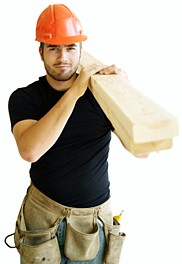Types of Hammers
There is a wider variety of hammer types than many novice do-it-yourselfers may realize, and since specific types of hammers can make certain tasks easier or possible, knowing about (and possibly owning) several types of hammers may be a good choice. These are five of the main types:
Claw Hammers
The curved claw hammer may be among the first, or indeed the only tool that homeowners first purchase. It is used both for nailing and for nail-pulling. If, for example, a nail is going in crooked or you are taking something apart, the split in the claw allows you to catch the nail’s head and use a twisting or leveraging movement to remove it. The surface of the hammer face is slightly convex to minimize marring the surface when a nail is driven in flush with the wood.
Curved claw hammers are sold by weight, with 7 oz., 13 oz., 16 oz., and 20 oz. models available. The 7 oz. hammer is useful for light work only. Many people who only need one hammer choose the 16 oz. model.
Another type of claw hammer is the straight claw hammer. Also known as a ripping claw, it is used for dismantling items. The straight claw fits between boards for easy prying. These hammers are a bit heavier, typically 20, 28, or 32 ounces.
 Tack Hammers
Tack Hammers
Used for crafting, mounting and hanging pictures, and upholstery, the tack hammer is handy when a lighter touch is needed. Magnetic tack hammers hold the tack to the head with the point facing out for easier application.
Ball-Peen (or Pien) Hammers
Peening means the technique of surface-hardening or working metal by hammering it. A ball-peen hammer is the tool that is used. The reference to ball in the name refers to the fact that the hammer has one flat side and one hemispherical side on its head. There are also point-peen and chisel-peen hammers. Homeowners may find it handy for use with punches and chisels.
Mallets
Mallets are handles with short heads that may be made of wood, plastic, or rubber, as well as rawhide, copper, or lead. They are used to shape metal, to drive chisels, and for fitting pieces together by tapping them into place, for example, hinge-pins or plasterboard, which would be damaged if a metal-headed hammer were used. The large, flat mallet head distributes the force over more of the surface.
Mallets are also used in craft work, such a leatherwork and jewelry, and in the kitchen, for example, to crack ice or tenderize meat. These mallets are each specialized for their task.
Sledge Hammers
The heaviest type of hammer, these long-handled tools are used for heavy work of several types. With heads weighing from two (907 g) to 20 (9.07 kg) pounds, sledge hammers are most often wielded with two hands. They are used to drive wedges, to place posts, and to break drywall or masonry in preparation for rebuilding or remodeling.
Written by Mary Elizabeth
Related Home Institute Articles
